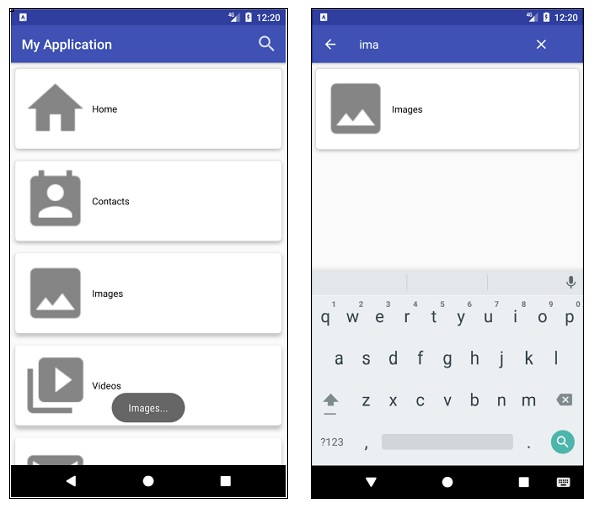
 Data Structure
Data Structure Networking
Networking RDBMS
RDBMS Operating System
Operating System Java
Java MS Excel
MS Excel iOS
iOS HTML
HTML CSS
CSS Android
Android Python
Python C Programming
C Programming C++
C++ C#
C# MongoDB
MongoDB MySQL
MySQL Javascript
Javascript PHP
PHP
- Selected Reading
- UPSC IAS Exams Notes
- Developer's Best Practices
- Questions and Answers
- Effective Resume Writing
- HR Interview Questions
- Computer Glossary
- Who is Who
How to filter a RecyclerView with a SearchView on Android?
This example demonstrates how to filter a RecyclerView with a SearchView on Android.
Step 1 − Create a new project in Android Studio, go to File ⇒ New Project and fill all required details to create a new project.
Step 2 − Add the following code to res/layout/activity_main.xml.
<?xml version="1.0" encoding="utf-8"?> <androidx.constraintlayout.widget.ConstraintLayout xmlns:android="http://schemas.android.com/apk/res/android" xmlns:app="http://schemas.android.com/apk/res-auto" xmlns:tools="http://schemas.android.com/tools" android:layout_width="match_parent" android:layout_height="match_parent" tools:context=".MainActivity"> <android.support.v7.widget.RecyclerView android:id="@+id/recyclerView" android:layout_width="match_parent" android:layout_height="match_parent" android:padding="4dp" android:scrollbars="vertical" app:layout_constraintBottom_toBottomOf="parent" app:layout_constraintEnd_toEndOf="parent" app:layout_constraintStart_toStartOf="parent" app:layout_constraintTop_toTopOf="parent" /> </androidx.constraintlayout.widget.ConstraintLayout>
Step 3 − Add the following code to src/MainActivity.java
package com.app.sample;
import android.os.Bundle;
import android.view.Menu;
import android.view.MenuInflater;
import android.view.MenuItem;
import android.view.inputmethod.EditorInfo;
import android.widget.SearchView;
import androidx.appcompat.app.AppCompatActivity;
import androidx.recyclerview.widget.LinearLayoutManager;
import androidx.recyclerview.widget.RecyclerView;
import java.util.ArrayList;
import java.util.List;
public class MainActivity extends AppCompatActivity {
private ExampleAdapter adapter;
private List<ExampleItem> exampleList;
@Override
protected void onCreate(Bundle savedInstanceState) {
super.onCreate(savedInstanceState);
setContentView(R.layout.activity_main);
fillExampleList();
setUpRecyclerView();
}
private void fillExampleList() {
exampleList = new ArrayList<>();
exampleList.add(new ExampleItem(R.drawable.ic_android, "One", "Ten"));
exampleList.add(new ExampleItem(R.drawable.ic_audio, "Two", "Eleven"));
exampleList.add(new ExampleItem(R.drawable.ic_sun, "Three", "Twelve"));
exampleList.add(new ExampleItem(R.drawable.ic_android, "Four", "Thirteen"));
exampleList.add(new ExampleItem(R.drawable.ic_audio, "Five", "Fourteen"));
exampleList.add(new ExampleItem(R.drawable.ic_sun, "Six", "Fifteen"));
exampleList.add(new ExampleItem(R.drawable.ic_android, "Seven", "Sixteen"));
exampleList.add(new ExampleItem(R.drawable.ic_audio, "Eight", "Seventeen"));
exampleList.add(new ExampleItem(R.drawable.ic_sun, "Nine", "Eighteen"));
}
private void setUpRecyclerView() {
RecyclerView recyclerView = findViewById(R.id.recycler_view);
recyclerView.setHasFixedSize(true);
RecyclerView.LayoutManager layoutManager = new LinearLayoutManager(this);
adapter = new ExampleAdapter(exampleList);
recyclerView.setLayoutManager(layoutManager);
recyclerView.setAdapter(adapter);
}
@Override
public boolean onCreateOptionsMenu(Menu menu) {
MenuInflater inflater = getMenuInflater();
inflater.inflate(R.menu.example_menu, menu);
MenuItem searchItem = menu.findItem(R.id.action_search);
SearchView searchView = (SearchView) searchItem.getActionView();
searchView.setImeOptions(EditorInfo.IME_ACTION_DONE);
searchView.setOnQueryTextListener(new SearchView.OnQueryTextListener() {
@Override
public boolean onQueryTextSubmit(String query) {
return false;
}
@Override
public boolean onQueryTextChange(String newText) {
adapter.getFilter().filter(newText);
return false;
}
});
return true;
}
}
Step 4 − Add the following code to src/ExampleItem.java
package com.app.sample;
public class ExampleItem {
private int imageResource;
private String text1;
private String text2;
public ExampleItem(int imageResource, String text1, String text2) {
this.imageResource = imageResource;
this.text1 = text1;
this.text2 = text2;
}
public int getImageResource() {
return imageResource;
}
public String getText1() {
return text1;
}
public String getText2() {
return text2;
}
}
Step 5 − Add the following code to src/ExampleAdapter.java
package com.app.sample;
import android.view.LayoutInflater;
import android.view.View;
import android.view.ViewGroup;
import android.widget.Filter;
import android.widget.Filterable;
import android.widget.ImageView;
import android.widget.TextView;
import androidx.annotation.NonNull;
import androidx.recyclerview.widget.RecyclerView;
import java.util.ArrayList;
import java.util.List;
public class ExampleAdapter extends
RecyclerView.Adapter<ExampleAdapter.ExampleViewHolder> implements Filterable {
private List<ExampleItem> exampleList;
private List<ExampleItem> exampleListFull;
class ExampleViewHolder extends RecyclerView.ViewHolder {
ImageView imageView;
TextView textView1;
TextView textView2;
ExampleViewHolder(View itemView) {
super(itemView);
imageView = itemView.findViewById(R.id.image_view);
textView1 = itemView.findViewById(R.id.text_view1);
textView2 = itemView.findViewById(R.id.text_view2);
}
}
ExampleAdapter(List<ExampleItem> exampleList) {
this.exampleList = exampleList;
exampleListFull = new ArrayList<>(exampleList);
}
@NonNull
@Override
public ExampleViewHolder onCreateViewHolder(@NonNull ViewGroup parent, int viewType) {
View v = LayoutInflater.from(parent.getContext()).inflate(R.layout.example_item, parent, false);
return new ExampleViewHolder(v);
}
@Override
public void onBindViewHolder(@NonNull ExampleViewHolder holder, int position) {
ExampleItem currentItem = exampleList.get(position);
holder.imageView.setImageResource(currentItem.getImageResource());
holder.textView1.setText(currentItem.getText1());
holder.textView2.setText(currentItem.getText2());
}
@Override
public int getItemCount() {
return exampleList.size();
}
@Override
public Filter getFilter() {
return exampleFilter;
}
private Filter exampleFilter = new Filter() {
@Override
protected FilterResults performFiltering(CharSequence constraint) {
List<ExampleItem> filteredList = new ArrayList<>();
if (constraint == null || constraint.length() == 0) {
filteredList.addAll(exampleListFull);
} else {
String filterPattern = constraint.toString().toLowerCase().trim();
for (ExampleItem item : exampleListFull) {
if (item.getText2().toLowerCase().contains(filterPattern)) {
filteredList.add(item);
}
}
}
FilterResults results = new FilterResults();
results.values = filteredList;
return results;
}
@Override
protected void publishResults(CharSequence constraint, FilterResults results) {
exampleList.clear();
exampleList.addAll((List) results.values);
notifyDataSetChanged();
}
};
}
Step 6 − Add the following code to res/layout/example_item.xml
<?xml version="1.0" encoding="utf-8"?> <android.support.v7.widget.CardView xmlns:android="http://schemas.android.com/apk/res/android" xmlns:app="http://schemas.android.com/apk/res-auto" android:orientation="vertical" android:layout_width="match_parent" android:layout_height="wrap_content" android:layout_marginBottom="4dp" app:cardCornerRadius="4dp"> <RelativeLayout android:layout_width="match_parent" android:layout_height="match_parent" android:layout_margin="4dp"> <ImageView android:id="@+id/image_view" android:layout_width="50dp" android:layout_height="50dp" android:padding="2dp" /> <TextView android:id="@+id/textView1" android:layout_width="wrap_content" android:layout_height="wrap_content" android:layout_alignParentTop="true" android:layout_toEndOf="@+id/image_view" android:text="Line 1" android:textColor="@android:color/black" android:textSize="20sp" android:textStyle="bold" /> <TextView android:id="@+id/textView2" android:layout_width="wrap_content" android:layout_height="wrap_content" android:layout_below="@+id/text_view1" android:layout_marginStart="8dp" android:layout_toEndOf="@+id/image_view" android:text="Line 2" android:textSize="15sp" /> </RelativeLayout> </android.support.v7.widget.CardView>
Step 7 − Add the following code to res/menu/example_menu.xml
<?xml version="1.0" encoding="utf-8"?> <menu xmlns:android="http://schemas.android.com/apk/res/android" xmlns:app="http://schemas.android.com/apk/res-auto" android:orientation="vertical" android:layout_width="match_parent" android:layout_height="match_parent"> <item android:id="@+id/actionSearch" android:title="Search" app:showAsAction="ifRoom|collapseActionView" /> </menu>
Step 8 − Add the following code to Manifest/AndroidManifest.xml
<?xml version="1.0" encoding="utf-8"?> <manifest xmlns:android="http://schemas.android.com/apk/res/android" package="com.app.sample"> <application android:allowBackup="true" android:icon="@mipmap/ic_launcher" android:label="@string/app_name" android:roundIcon="@mipmap/ic_launcher_round" android:supportsRtl="true" android:theme="@style/AppTheme"> <activity android:name=".MainActivity"> <intent-filter> <action android:name="android.intent.action.MAIN" /> <category android:name="android.intent.category.LAUNCHER" /> </intent-filter> </activity> </application> </manifest>
Let's try to run your application. I assume you have connected your actual Android Mobile device with your computer. To run the app from the android studio, open one of your project's activity files and click Run ![]() icon from the toolbar. Select your mobile device as an option and then check your mobile device which will display your default screen −
icon from the toolbar. Select your mobile device as an option and then check your mobile device which will display your default screen −

Click here to download the project code.

